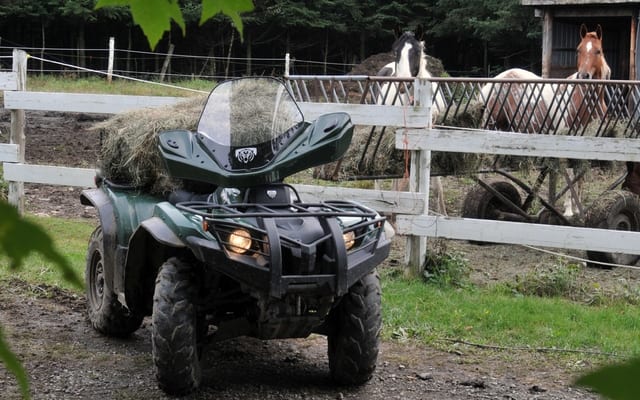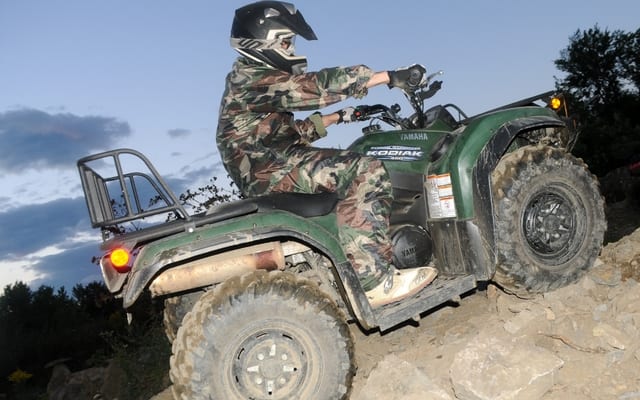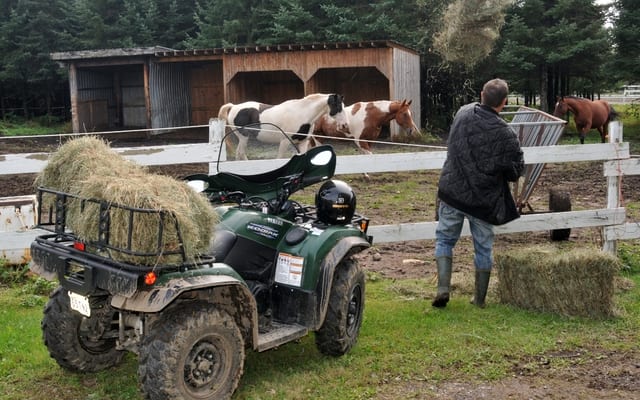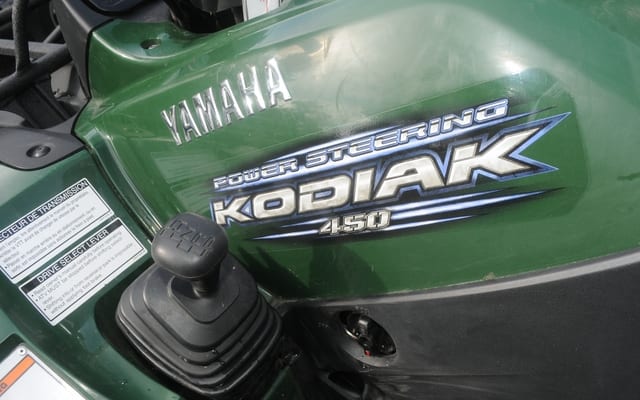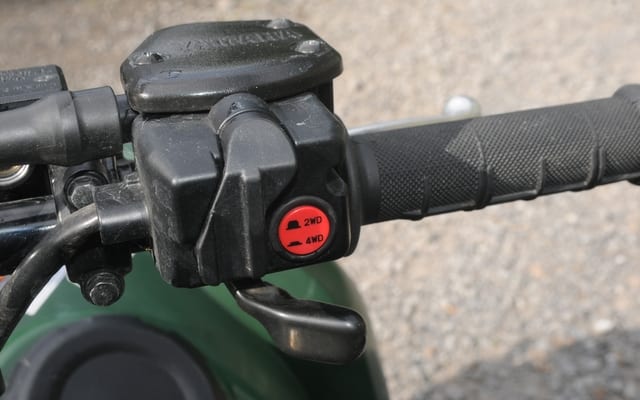Kodiak bears are generally solitary in nature, demonstrating particularly more acute abilities than their Grizzly cousin. This seems to be true of the new 2010 Yamaha Kodiak 450 EPS as well; which is much more than just a less-powered version of the Grizzly 700. It has its very own distinct feel to it, as the inclusion of a large group of very well-conceived and time-tested technological features, combine together with more newly acquired talents, to create a similar symbiosis with nature. With the addition of EPS, the Kodiak is ready to conquer even more of life’s tough daily challenges. The sensory perception or intelligence of the Kodiak bear has been observed to be greater than that of the Grizzly, giving it an edge in combatting nature’s sometimes unforgiving challenges. Could it be that the 2010 Yamaha Kodiak 450 EPS can outperform the Grizzly ATV as well?
Yamaha’s naming choice is perfectly fitting for such a ride; the Kodiak long has been a trusted mid-size quad in the workplace, on the farm or ranch, and for hunters and fishermen looking for a hassle-free reliable quad. It is meant to survive the harshest conditions found in nature and keep going, until the user is completely done with the task at hand. Nobody likes to have to cancel a planned ride, stay stuck way out there in the middle of nowhere, or lose their work buddy right in the middle of a project. This ATV is truly designed with a focus on practicality, solidity and mechanical toughness. Those qualities can certainly appeal to all of us, regardless if you buy a quad for fun long treks in tough trails or everyday work.
Yamaha’s fully automatic Ultramatic transmission is known to be one of the most reliable transmissions in the ATV industry. That was palpable as I jerked it around to try and find any lag in the system, and instead found that it stayed very smooth all the time, even when aggressively switching from a full throttle position to completely locking up the wheels and releasing them again. In Low range, the clutch grabbed like a tractor, with instantaneous response to a mere feathering of the throttle. The powerful 421cc, 4-stroke, SOHC, liquid-cooled engine shined the most, when we were making it work hard with heavy loads. Our ultimate test for low end torque and traction, involves hooking up different rides to a particularly unfriendly small ground groomer, homemade by our good friend Ben, for the maintenance of his small horse rink. He usually pulls it with his big farm tractor with no struggle. Part of the rink was turned into a 6 inch deep carpet of wet sand, which created a different kind of mud than I am used to encounter when in the trails. It certainly had much stickier feel to it.
That is a simple, yet challenging task at hand, made for the perfect opportunity to make a fun comparison. It so happened that we also had another excellent ride for daily hard work: a Polaris Sportsman 550 X2. And so grooming time it was. I would start by rolling on the other 75% of the rink, which was damp, yet a much lighter shade of brown than that one dreaded muddy corner. I had to gain as much speed as possible from each ride, to counter the accumulating sticky stuff on the tool dragged behind. I took all that each could give me; in other words, I simply went full throttle with both and never let go until I was immobile with all four tires spitting up a shower of mud. The conditions were very similar to what you would see in a typical tractor pull competition. I paid close attention to my choice of line to not roll on the same spot twice, in order to have one work as hard as the other had, of course. It turned out to be pretty much of a tie after it all; both of them sort of died down in useless spinning at the same spot, yet the Kodiak’s transmission seemed less bothered by the strain of this test, and the ride had kept advancing ever so slightly, little by little, before completely stopping; compared to the other one that started smelling funny, as soon as the vehicle stopped moving with my thumb still full on the gas.
The experience was very telling of both machines’ surprising strength in such extreme conditions, and also made it clear that both had excellent splash protection. It just so happened that our Kodiak test unit was conveniently equipped with TRIC fender extensions, but I could tell by the shape of the Grizzly inspired plastics, that it does a great job at keeping the rider clean even without them. The ride also had a windshield and a gate for the rear rack, which turned out to be extra useful when carrying a few loose hay bales, to feed the horses. The windshield was very easy to install and remove, with large knobs on the anchoring bolts, so you could turn them fast and easy without any need for tools. Those would only secure the brackets, which were already enough to stay held in place without the bolts inserted; they have a slip-on maze like shapes moulded into them, which dictate perfect alignment in one easy snap. Only one fact about that windshield bothered me, the reflections in the mirrors, were way too deformed. Introduced by Yamaha Motor Canada in the late 1970’s, the iconic TRIC brand was recently reintroduced to better serve the needs of Canadian motorsport enthusiasts. TRIC, meaning: Tested, Reliable, Innovative, and Canadian, representing the quality accessories line made available only through their premium Yamaha dealer network.
Most of today’s utility quads are equipped with true engine braking; to give you added control, when descending steep hills. This one is among those, but does so in a less aggressive fashion than many others. So set, its behaviour, when simply braking on flat grounds, is much better than any North American built quad. Despite its presence still being clearly felt when letting off the gas at higher speed, there was no sticking action upon releasing, like many others do. This precise control on braking gave me a much a better sense of security, and it worked in perfect conjunction with a stability, which is without exaggeration, the most efficient in the whole industry. That ride is noticeably better at sticking all four wheels to the ground than any other. While carving through tight trails at a fun pace, I even tried to encourage instability by putting weight on the wrong side, and the Kodiak just wouldn’t have it. That incredible behavioural trait pushed me to further investigate this high stability factor on wide-opened grounds.
Absolutely amazing! I couldn’t believe it; I was actually unable to climb one side of the quad to its tilting point, and certainly not keep it balanced there, as I normally have no trouble doing with others. The quad would just keep this constant and strong pulling effect to get back on all four wheels. Curious to find out where exactly this balance point was, I asked my buddy to help me lift the Kodiak on two side wheels to its balance point and found it to be extremely high. So much so, that it stood in a position that would be impossible to maintain while rolling, without grinding the rims to the ground. When comparing its weight to others in the same class, we find that it is among the lightest and so this could not explain why it was looking to stick so well. The answer is: the way this weight is distributed and how low the center of gravity is kept, explain this magical quality!
Sadly, the accent on Utility, can many times take some of the fun factor out, and that could also be felt on this quad; after profiting from its decisive acceleration, it sort of dies down to a stable and less exciting cruising speed, which kind of left me wanting more, when in flatter wide-opened spaces. The power output isn’t quite enough to send it into excitingly long power slides. Only if you slow down and profit from the engine’s low end torque, and convince it with a quick turn of the handlebar, which is of course, now extremely easy to do, with the addition of EPS, will the rear Maxxis tires unhook significantly. All perfect characteristics for someone who wants a safe and logically set ride to share with loved ones.
EPS (Electronic Power Steering) makes the good old Kodiak all the more appealing for work, and I also discovered that it ties in perfectly with the rides’ incredible stick to the ground feel, and very tight turning radius. It meant much less front to back moves and gears changes to manoeuvre in tight spots, I could turn more sharply and faster than on any other quad I have ever tried. Others might have as tight a turn radius, but this ride lets you do it a bit more quickly without it becoming an unsafe feeling manoeuvre. It would really be nice, if the shifter would be set a little higher, to stay out of your left knee’s reach, at any position. If I may suggest for tall guys like myself, when going into reverse gear, look behind you by twisting your body to the left side to avoid banging your knee into it. The shifter is perfectly placed for this to happen.
Surprisingly, the 2010 Yamaha Kodiak 450 EPS can hold itself in a drag race against many 500 machines, and can even carve its way through tight trails as fast as some even more powerful big-bore monsters, mainly because of all this extra stability it provides the rider with. It has a very low center of gravity, that creates an unmatched feeling of confidence and an almost impossible to tilt character. I still don’t think that racing through the woods, at full speed, is a good idea and you might want to be very careful with tight sequences of small bumps, which can make it feel hoppy a little at times. I just don’t think this is its intended type of usage, and yet it does ride very fast in turn generous winding wood trails, extremely well. EPS dramatically changes the whole ATV experience, completely pulling out steering effort from the equation. This is especially advantageous when in 4WD, where now this has no effect in changing the feel or input needed from the user. Set your suspension to the right choice of 5 spring preload adjustments, in accordance with your riding style and needs, and this is still a great ride for simple trail riding.
Selection of your traction mode is very well-placed within thumbs reach, and easily operated in a quick fashion, to reach the full traction capacity of 4WD, with Diff-lock engaged. A few moves are needed though: click in the red button for 4WD, then slide the small rotating plate, which hides the yellow Diff-lock button, and press that one. If bypassing the rev-limiter becomes necessary, you can press the grey override button just under your kill switch on the opposite left side, to get access to the whole fury of the engine. I’m not too sure if I like having to take care of all this manually anymore, now that I’ve enjoyed most results and the convenience obtained with other automatic differential locking systems. This aspect seems only one of many to make this ride better-suited for the needs of workers who want or need more precise control of what their machine does.
I don’t think that not adding Electronic Fuel Injection is merely to keep the cost down; use of a manual choke, which is by the way, very well placed and smooth to operate, is something that remains much more appealing to some. It is no mystery that the computerization of engine technology is ever growing, and getting better and better reliability wise, but the fact remains that electronically caused problems can occur, and be challenging to solve when in the middle of a trail ride and the vehicle starts doing strange things. I think that in this case, use of long trusted and simpler carburation, only adds to this ride’s high score in reliability. Sealed marine-style electrical connectors are used to prevent water infiltration into electrical components and wiring, convenient electric starting from any gear and a 12-volt D.C. terminal that provides a convenient power source for accessories, further contribute in making the Kodiak a trustworthy partner at work.
The Kodiak remains true to its name, providing more than just good power and handling, but now adds an ease and safety level that could actually serve as a benchmark in the conception of any other types of off road vehicles. I strongly recommend the 2010 Yamaha Kodiak 450 EPS to anyone who rides quads on a daily basis!
For more information on the above mentioned models, please visit the Yamaha Motor Website
More from Yamaha on ATV Trail Rider :
Yamaha ATV Models – Yamaha UTV Models – Yamaha ATV Reviews – Yamaha UTV Reviews


